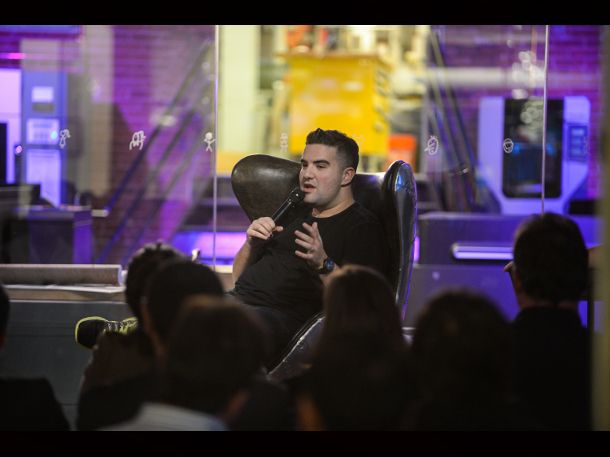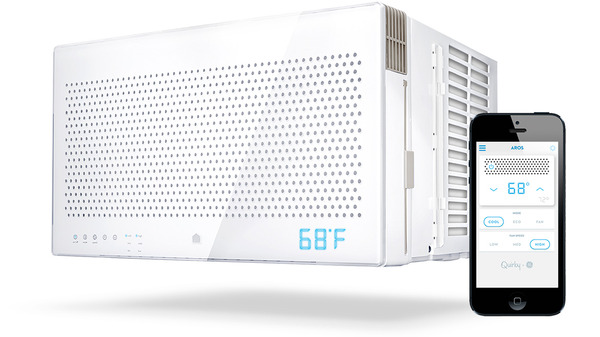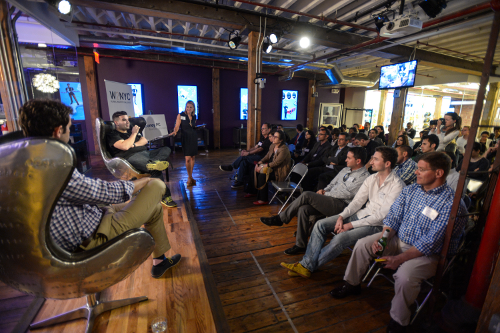
Anyone can submit their idea for an invention to Quirky. If the staff and community like the idea and it makes it through the evaluation process, the company will produce the item and sell it on their website. The inventor will receive a percentage of the revenue of the product’s gross sales.
Quirky, the Chelsea based innovation and technology enabler founded in 2009, has become the face of the “maker” movement; the company strives to make invention accessible to anyone with a good idea. Quirky is unlike any ordinary crowdsourcing site – it acts as an intermediary and provides resources for production, conceptualization, and kinship for its inventors.Having developed over 300 products—and with over 855 thousand innovators in its community—Quirky is now entering its next stage of development and is showcasing what bespoke manufacturing and prototyping will look like in the future. While New York lost thousands of jobs in manufacturing over the last 10 years, Quirky’s innovation labs are one of the hallmark ways in which the city is bringing these opportunities back.During the World to NYC New Manufacturing Challenge program, Alex Tepper, Global Director of Innovation at GE, along with Quirky CEO, Ben Kaufman, sat down to discuss collaboration between large and small companies, fast prototyping, and other trends in the maker space. Here, we highlight three key ingredients taking this company, and this partnership, forward:
Partnership between Large and Small Companies
“Don’t be scared to partner with big companies.” – Alex Tepper This May Quirky’s Aros Window Air Conditioner will launch. The Aros was an idea dreamed up by Garthen Leslie, a 63-year-old from Columbia, Maryland who spent years working at the Department of Energy. Leslie had been thinking of ways to improve air conditioning by reducing costs to the consumer. With the Aros, consumers are able to control the air conditioner via an app, even when they’re not in their apartments. The $300 unit embraces the Internet of Things (IoT) concept, and the hope is that this product will be the one to catapult the IoT concept to the next level of consumer demand.
This May Quirky’s Aros Window Air Conditioner will launch. The Aros was an idea dreamed up by Garthen Leslie, a 63-year-old from Columbia, Maryland who spent years working at the Department of Energy. Leslie had been thinking of ways to improve air conditioning by reducing costs to the consumer. With the Aros, consumers are able to control the air conditioner via an app, even when they’re not in their apartments. The $300 unit embraces the Internet of Things (IoT) concept, and the hope is that this product will be the one to catapult the IoT concept to the next level of consumer demand.
• Leverage the benefits of working with both a startup and a legacy company
• Opportunities for shared know-how and unique partnerships
• Access to capital funding from a large corporation with the dexterity of a startup
• Fast turn-around time bringing products to market
The fast development of Aros is the result of a collaboration between Quirky and GE. The product is a patent-sharing partnership highlighting one of the many ways in which large and small corporations can embrace new forms of manufacturing. The product was in line with the company’s new venture with GE and was developed in a matter of months. “It took 410 days to build the empire state building, why should it take four years to build an appliance?” said Kaufman. The partnership with GE was important in taking this product to market. While GE has the regulatory know-how, Quirky is good at the creative; it has the connections with a community of over 1 million innovators. Through the program, Quirky innovators have access to some of GE’s library of patents to imagine innovative consumer products of the future.
Innovation Sharing
“The best ideas were locked in peoples heads.” – Ben KaufmanMicro-run and bespoke production activity is flourishing in New York City and new companies and communities are being created to support it. Anyone who walks into the company’s office can get a sense of the company’s open innovation mantra. The elevators open right into a workshop where a number of the company’s successful inventions are displayed. Beyond the foyer is an event space that peers into a room full of 3D printers actively bringing concepts to reality. The idea of open innovation is one that is growing in popularity amongst the technology community. Also known as user innovation, cumulative innovation, know-how trading, mass innovation, and distributed innovation, the concept is that companies should use external and internal ideas to advance technology. Quirky does not take over a patent for anything unless they commit to the idea, which, up front, protects the interests of inventors.
The Fast-Moving Face of Urban Manufacturing
“We try not to make decisions the way most companies do.” – KaufmanPrototyping is expected to continue its growth in New York City as proximity to experts, services, and resources make it easy to get things done faster and cheaper. New areas of the city are emerging to reap the benefits of industrial growth, particularly in areas of Brooklyn where once desolate areas are being reclaimed to support this budding industry. At Quirky, products typically take 100-120 days to bring to market—its record was 29 days. Every Thursday it selects new products to develop. With its speed and unique style Quirky has become one of the highlight companies in the NYC innovation world. Its reputation is cool, inspired and, well, quirky. Its founder, twenty-something-year-old entrepreneur Ben Kaufman was able to raise more than $1 million at 19 for his iPod accessory company Mophie, which he launched in high school. Kaufman stands as an inspiration to Quirky employees and others in the maker space who want to be entrepreneurial and attract the brightest millennial minds. This is the kind of environment adaptable for companies that will create the products of the future and build the local economy.
At Quirky, products typically take 100-120 days to bring to market—its record was 29 days. Every Thursday it selects new products to develop. With its speed and unique style Quirky has become one of the highlight companies in the NYC innovation world. Its reputation is cool, inspired and, well, quirky. Its founder, twenty-something-year-old entrepreneur Ben Kaufman was able to raise more than $1 million at 19 for his iPod accessory company Mophie, which he launched in high school. Kaufman stands as an inspiration to Quirky employees and others in the maker space who want to be entrepreneurial and attract the brightest millennial minds. This is the kind of environment adaptable for companies that will create the products of the future and build the local economy.

